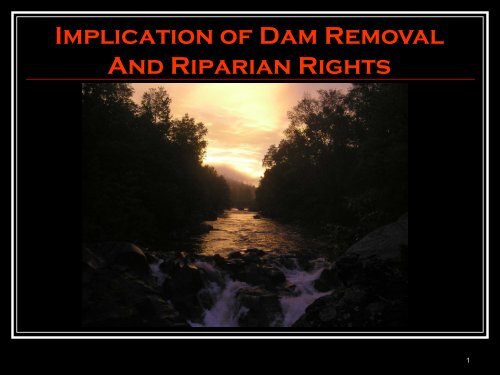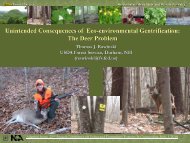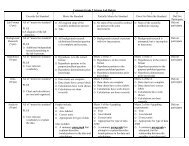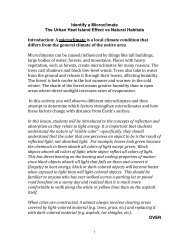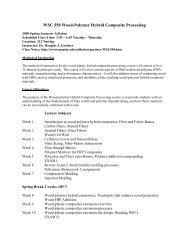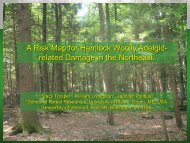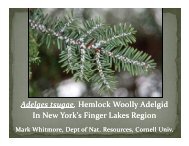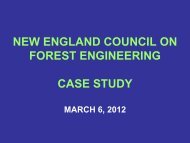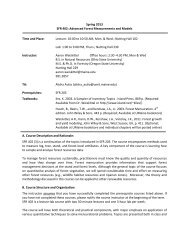Implication of Dam Removal And Riparian Rights
Implication of Dam Removal And Riparian Rights
Implication of Dam Removal And Riparian Rights
Create successful ePaper yourself
Turn your PDF publications into a flip-book with our unique Google optimized e-Paper software.
<strong>Implication</strong> <strong>of</strong> <strong>Dam</strong> <strong>Removal</strong><br />
<strong>And</strong> <strong>Riparian</strong> <strong>Rights</strong><br />
1
<strong>Riparian</strong> <strong>Rights</strong><br />
<strong>Riparian</strong>: Of or pertaining to or situated or fronting on a<br />
river, stream, lake or pond.<br />
(Sometimes used interchangeably with the term littoral.)<br />
With regards to real property it may refer to those rights<br />
appertaining to or limiting land fronting on a water body.<br />
Those rights may include the extent <strong>of</strong> ownership, rights<br />
to take the water or water power from the water body,<br />
the right to navigate or restrict navigation adjacent to the<br />
property and the rights <strong>of</strong> others including the public to<br />
utilize the water and the water body.<br />
2
Thus, in considering this subject, we find the public right <strong>of</strong><br />
way over the stream, and the land owner's right <strong>of</strong> soil under it, and<br />
his right to use its flow. The rights <strong>of</strong> both these parties are<br />
necessary for the purposes <strong>of</strong> commerce, agriculture, and<br />
manufactures. The products <strong>of</strong> the forest would be <strong>of</strong> little value if<br />
the riparian proprietors have no right to raise the water by dams and<br />
erect mills for the manufacture <strong>of</strong> these products into lumber. The<br />
right to use the water <strong>of</strong> such streams for milling purposes, is as<br />
necessary as the right <strong>of</strong> transportation. Indeed, it is this<br />
consideration that <strong>of</strong>tentimes imparts the chief value to the estate <strong>of</strong><br />
the riparian proprietors, and without which it would have no value<br />
whatever in many instances. Each right is the handmaid <strong>of</strong><br />
civilization; and neither can be exercised without, in some degree,<br />
impairing the other. This conflict <strong>of</strong> rights, therefore, must be<br />
reconciled.<br />
LANCEY v. CLIFFORD, 54 Me. 487 (1867)<br />
11
In case <strong>of</strong> fresh water streams, when<br />
such stream is the boundary, the deed<br />
passes the fee to its centre. (ad medium<br />
filum aquae - the thread)<br />
... the thread <strong>of</strong> a stream is the middle line<br />
between the shores, irrespective <strong>of</strong> the<br />
depth <strong>of</strong> the channel, taking it in the<br />
natural and ordinary stage <strong>of</strong> water. The<br />
channel and the thread <strong>of</strong> the river are<br />
entirely different.<br />
The channel is the deepest part <strong>of</strong> the<br />
river.<br />
Warren v. Thomaston, 75 Me. 329, 332 (1883)<br />
31
“Thence along land <strong>of</strong> Jones<br />
Timber Co. 230 rods to the<br />
river; Thence northerly<br />
along the river 50 rods to<br />
land <strong>of</strong> Farmer Smith, ....”<br />
“Thence along land <strong>of</strong> Jones<br />
Timber Co. 230 rods to the<br />
bank <strong>of</strong> the river; Thence<br />
northerly along the bank <strong>of</strong><br />
the river 50 rods to land <strong>of</strong><br />
Farmer Smith, ....”<br />
Lowell v. Robinson, 16 Me. 357 (1839)<br />
32
But prima facie... the general rule must be to take lines, at right<br />
angles with the course <strong>of</strong> the stream, to its thread or middle<br />
line.<br />
The object is to give to each riparian proprietor an equal share<br />
<strong>of</strong> the bed <strong>of</strong> the river, in proportion to his line on the margin<br />
<strong>of</strong> the stream, together with that portion <strong>of</strong> the bed <strong>of</strong> the<br />
stream, which lies opposite, in front <strong>of</strong>, or adjacent to, his<br />
upland; and this, in the absence <strong>of</strong> any controlling grant, will<br />
be effected by the straight lines, at right angles, which will in<br />
general be the shortest and most direct lines, to the thread <strong>of</strong><br />
the stream. <strong>And</strong> we cannot perceive how this consideration<br />
can be influenced by the shape <strong>of</strong> the upland lot, or by the<br />
direction <strong>of</strong> its side lines back from the river.<br />
Knight vs. Wilder, 56 Mass. 199 (1848); 2 Cush. 199 (1848)<br />
40
OTHER AND RELATED ISSUES TO DAM<br />
REMOVAL AND ALTERATIONS<br />
Natural Deterioration <strong>And</strong> Structural Decline<br />
Drainage Alteration During Construction Or<br />
Maintenance – Dredging, Filling Etc.<br />
Obligations To Maintain & Financial Burden<br />
Title Transfer<br />
Permitting Issues – Local, State, Federal<br />
Aesthetic Issues<br />
Large Ponds Or Lakes When Waters Recede<br />
43


